Every marketer faces the challenge of standing out in a flooded inbox. Relying solely on intuition and experimentation can make it harder for marketers to achieve results. A more data-driven, strategic approach can make all the difference. With over 4.3 billion global email users, there is enough user data to remove the guesswork.
Data-driven email marketing derives insights from customer data to craft personalized and contextual emails that convert. Emails are cost-effective marketing channels, delivering an average email marketing ROI of $36 for every dollar spent. You can make the most out of the money invested by utilizing the email marketing data to cater to user needs and interests.
This blog will cover the importance of data in email marketing, the types of data and data-driven emails marketers can use, a step-by-step guide to build a data-driven email marketing strategy, best practices to implement, and common pitfalls to avoid. It will also cover some real-life examples of data-driven emails.
What is Data-Driven Email Marketing?
Data-driven email marketing relies on customer data to create, personalize, and optimize hyper-relevant and dynamic email campaigns for maximum effectiveness. The data can be obtained by analyzing customer demographics, behavior, preferences, and engagement history with the brand.
Traditional email marketing was static and used generic emails with batch-and-blast email newsletters, hoping the message would resonate. It relied more on gut feeling instead of actionable insights that come with access to real-time customer engagement metrics and user behavior.
Why Data Matters in Email Marketing
Not all customers are in the same stage of their buyer journey. It makes no sense to send the same email to a new user and a repeat buyer. The new user needs an onboarding guide, while a repeat buyer is looking for new product recommendations or ways to use the latest update.
How will marketers determine this difference and send relevant emails to each user group?
The answer is DATA.
Behavioral, psychographic, and demographic data can be used to segment the audience and write emails with content that resonates with each segment. This data can be further used to hyper-personalize subject lines, product recommendations, and messaging to increase engagement. Email marketing tools use customer data to automate launching email sequences triggered by user behavior or action.
Data-driven personalized emails generate more leads than generic emails, with a 29% higher open rate and 41% higher click rate. Data helps visualize what’s working and what’s not in an email marketing campaign. Ignoring data can lead to spending resources on irrelevant emails that don’t convert or spammy ones that don’t land in the subscriber’s inbox.
Key Types of Email Marketing Data You Should Track
Track these five key user data types for a successful data-driven email marketing strategy.
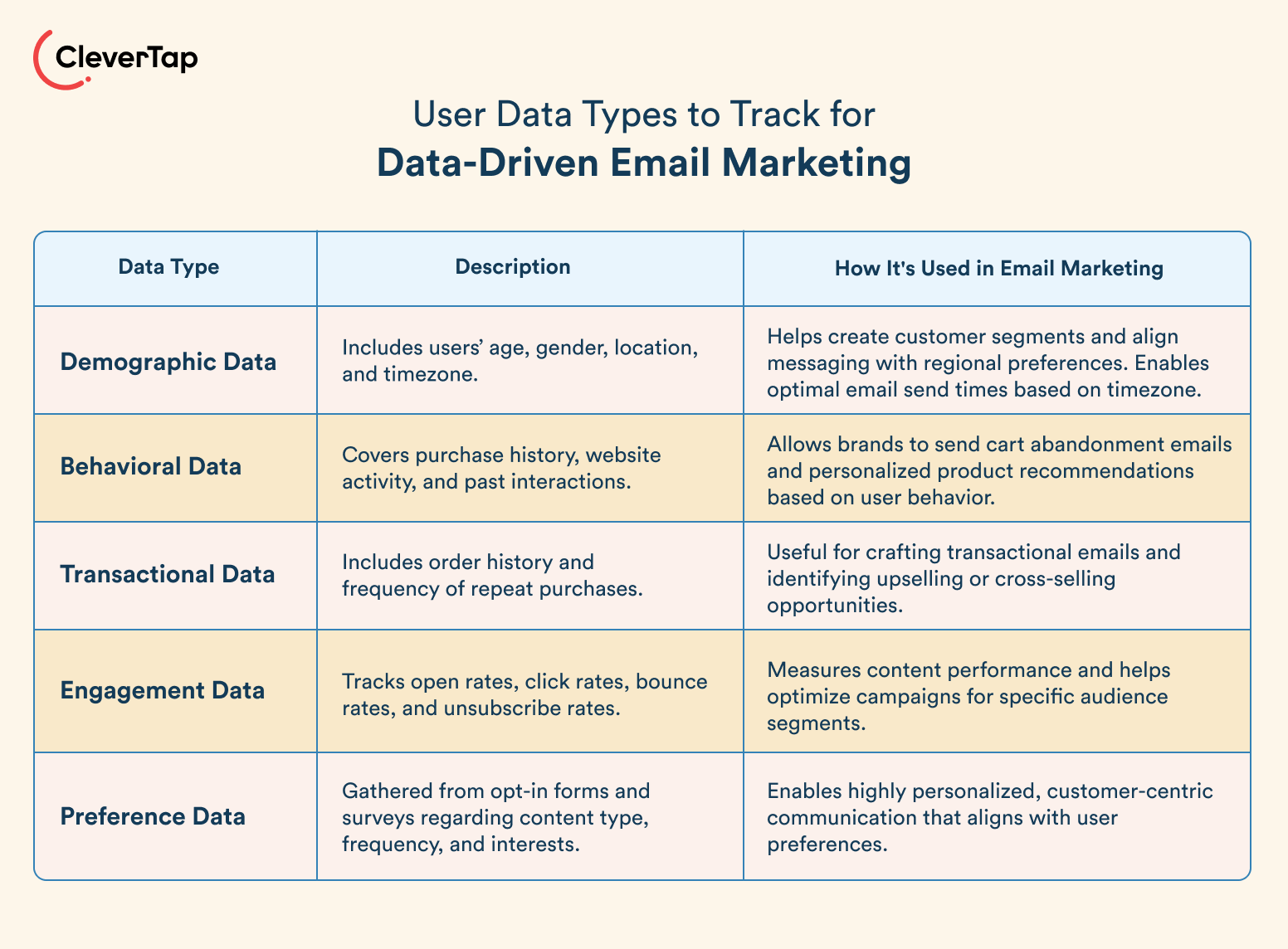
1. Demographic Data
Data on users’ age, gender, and location helps create customer segments and align offerings with regional preferences. For example, data about the customer’s timezone will enable marketers to send emails at the best time and peak activity hours for that zone.
Learn how to conduct demographic segmentation to understand your audience.
2. Behavioral Data
The user’s purchase history, website activity, and past communications shed light on their interaction behavior and patterns with the brand. Brands can use behavioral segmentation data to send cart abandonment emails or personalized product recommendations based on buying history.
3. Transactional Data
Information such as order details and purchase frequency can help craft transactional emails and identify upselling and cross-selling opportunities.
4. Engagement Data
Track engagement metrics like open rates, click rates, bounce rates, and unsubscribe rates to learn how well the content resonates with different audience segments and accordingly optimize the emails.
5. Preference Data
Customer preference data collected via opt-in forms and surveys tells marketers the content type, frequency, and context each customer prefers. It enables customer-centric communication catered to their interests.
Types of Data-Driven Emails That Work
Mentioned below are three types of data-driven emails that you can use.
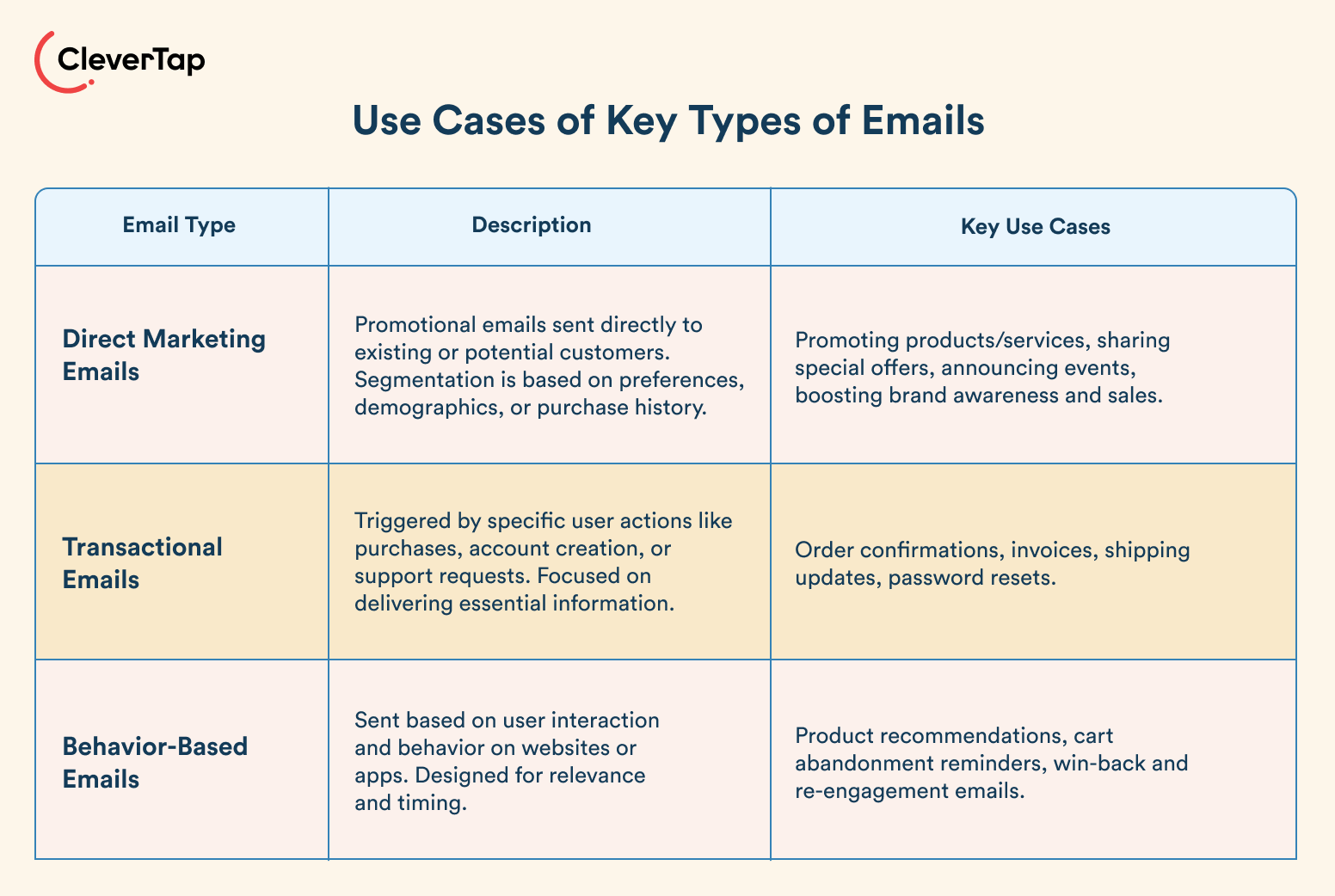
1. Direct Marketing Emails
Direct marketing emails are emails with promotional messages sent directly to potential or existing customers. They promote products or services, provide special offers, or share details of upcoming marketing events by segmenting recipients based on preference, demographics, or purchase history. The goal is to increase brand awareness, improve conversions, and generate more sales.
2. Transactional Emails
Transactional emails are triggered by user actions like a purchase, sign-up, or return request, to provide necessary information. Some examples include order confirmation emails, invoice generation emails, shipping and delivery details, and password resetting emails.
3. Behavior-Based Emails
Behavior-based emails are used to send timely and relevant content to users based on how they interact with the brand. Some examples include recommending products similar to the ones they browsed, sending cart abandonment reminder emails, and re-engagement or win-back campaigns for inactive users.
Building a Data-Driven Email Marketing Strategy: A Step-by-Step Guide
Let’s look at the different steps to follow for building effective data-driven email marketing strategies.

Step 1: Set Clear Goals
Ensure you set SMART goals before building the strategy for better tracking and optimization. The data driving the email marketing strategy will be defined by the campaign goal and business objectives. For example, the data you collect will depend on whether the emails focus on acquiring new customers, retaining existing ones, driving more sales, or re-engaging inactive users with a win-back campaign.
Step 2: Choose the Right Tools and Platforms
Choose email marketing platforms that integrate with your existing customer relationship management (CRM) tools and customer data platforms. Your email service provider (ESP) and analytics tool (often comes with the email marketing platform) should seamlessly integrate with your marketing tech stack for data flow without hiccups, real-time personalization, and advanced email automation. Ensure the email marketing platform has A/B and multivariate testing, audience segmentation, and dynamic content capabilities.
Step 3: Collect and Centralize Customer Data
Centralize customer data collected from all sources on one platform. Cover all touchpoints. Get the Google Analytics data on how users interact with your website. Collect data on email interactions, purchase history, data from opt-in forms and surveys, open and click rates, engagement, and email conversion rate to get a 360-degree view of your users on one platform.
CleverTap provides actionable insights in real time, which is essential for advanced segmentation, personalization, and mapping campaigns to the customer lifecycle.
Step 4: Segment Your Audience Intelligently
Do not group all your customers in the same category. Segment them based on demographics, behavioral, transactional, and engagement data. Group users by intent, preference, or customer journey stage.
With CleverTap, you can use such advanced email segmentation that allows marketers to send relevant messages that resonate with each group.
Step 5: Personalize Content and Timing Based On Behavior
With all the data on user behavior at your disposal, it is time to personalize the content to match the user’s intent. Aim to personalize the content beyond mentioning their first names. For example, brands can use dynamic content in emails to recommend products based on the user’s browsing history or past purchases.
Subject lines can be customized with this data to talk about recent interactions. Email marketing tools also analyze customer behavior to recommend optimal email send times and frequency.
Check out the tips and tricks you can use to ace your personalized email marketing strategy.
Step 6: Automate Campaigns Based on Triggers and Workflows
Scale your data-driven email marketing efforts by automating email sequences that get triggered based on user behavior or action. For example, send a series of customer onboarding emails as soon as a new customer signs up. Set up email automation workflows that track user inactivity over time and trigger emails every 30 days to re-engage inactive customers.
Step 7: Analyze, Test, and Optimize Continuously
Data is dynamic, and as it changes over time, the email marketing strategy will also change. Marketers need to continuously test and analyze the campaign performance and use the data to optimize. Follow email copywriting best practices to nail the content. A/B test different elements of the email, such as subject lines, CTAs, and design layout, to select the one that performs better.
Explore the email marketing metrics you must track to measure the success of your data-driven email marketing strategy.
How to Collect and Analyze Email Marketing Data
Ethical data collection reflects your brand’s values and helps build trust. Meet data privacy standards and consumer protection laws like the General Data Protection Regulation (GDPR). Collect data responsibly and obtain explicit consent from customers before gathering personal information. Mention how the data will be used and offer easy opt-out avenues. Use double opt-ins, keep your data privacy policies transparent, and adhere to user preferences.
Businesses can collect email marketing data from various sources. Some of them are mentioned below:
- Website forms to capture sign-in details and customer preferences.
- Get demographic data, lifecycle stage, and communication history from CRM systems.
- Gather data on product preference and buying behavior from purchase history.
- Use surveys and feedback forms to understand satisfaction levels.
- Track opens, clicks, bounces, and unsubscribes from the email marketing platform.
Now that the data collection part is over, how will you analyze this data? Here are three ways.
- A/B test subject lines, CTAs, content, and layout to understand what performs better.
- Perform cohort analysis. Segment users into groups based on shared attributes like signup date or purchase behavior. Analyze how the engagement and conversions vary across these cohorts.
- Use email marketing platforms with artificial intelligence (AI) and machine learning models for predictive analytics – predict churn risk, product recommendations, and optimal send times.
How CleverTap Can Help Bring Your Data-Driven Email Marketing Strategies to Life
CleverTap’s advanced email marketing platform has helped 2,000+ businesses rely on user data to effectively engage customers. Here’s how CleverTap helps businesses run successful data-driven email marketing campaigns.
- It integrates with a variety of customer data platforms (CDPs), eliminating the challenge of data silos.
- The platform provides email marketing automation to trigger behavior or action-based email sequences.
- Clever AI uses AI/ML for intent-based segmentation at the granular level to predict churn risk and business outcomes. This helps predict customer journey mapping.
- CleverTap’s Scribe crafts emotionally, hyper-personalized, intelligent AI-generated content that resonates with each user segment.
- It analyzes user data for personalized product recommendations.
- Enables A/B and multivariate testing to choose the best-performing email versions.
- IntelliNode recommends the optimal send time and frequency based on customer data.
Talk to us to get started with data-driven email marketing.
Real-Life Examples of Successful Data-Driven Email Campaigns
Here are three more real-life examples of data-driven email marketing campaigns that run on email marketing data.
How Booky Saw 36% Increase in Email Open Rates
Booky, a digital phonebook and restaurant booking app, used CleverTap’s email marketing platform to create automated email journeys, optimize email deliverability, and leverage up-selling and cross-selling opportunities. The company observed a 36% increase in email open rates. Here’s how CleverTap helped:
- Booky used advanced A/B testing to make data-driven decisions in delivering the best versions of emails to their users.
- The brand created hyper-personalized emails by building a rich user profile. They used CleverTap to capture granular insights like the user’s latest subscriptions to run upselling campaigns.
- Booky combined the features of CleverTap with their location data partner to map customer journeys. They then used this data to engage customers at different touchpoints – immediately after sign-in, after their free trial expires, or is nearing expiry.
- Booky provided its users with a hyper-personalized engagement experience by sending them reminders whenever the users are near a location they redeemed offers from in the past.
- The brand used CleverTap’s behavioral analytics to monitor user journey performance in real time and used those insights to optimize their campaigns.
Read the full case study here.
Asana: A Welcome Email Series
Asana, a work management platform, sends a series of hyper-personalized welcome emails.
Email 1: Nudges the user to get started on Asana Enterprise. The email talks about security features, highlighting the benefits of paying for an Enterprise account, and then walks the user through next steps.

Email 2: Once the user has set up their account, Asana welcomes them and nudges them to take action, in this case, the action is to create a task on Asana. Because this is a new user, the email also shares tips to get started.
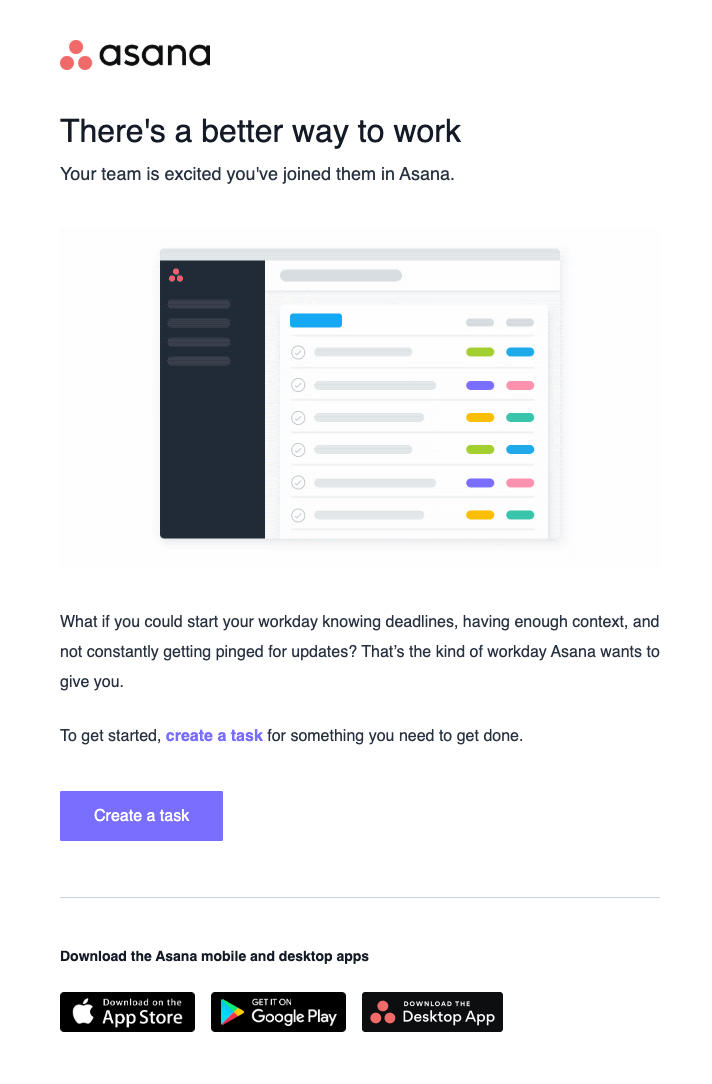
Email 3: An email sent after the user has set up a project on Asana. The email shows a checklist of items the user can do next, while upselling Asana’s Academy courses. This gives the user a good view of how far they’ve come with the product, and what they need to go to level up.
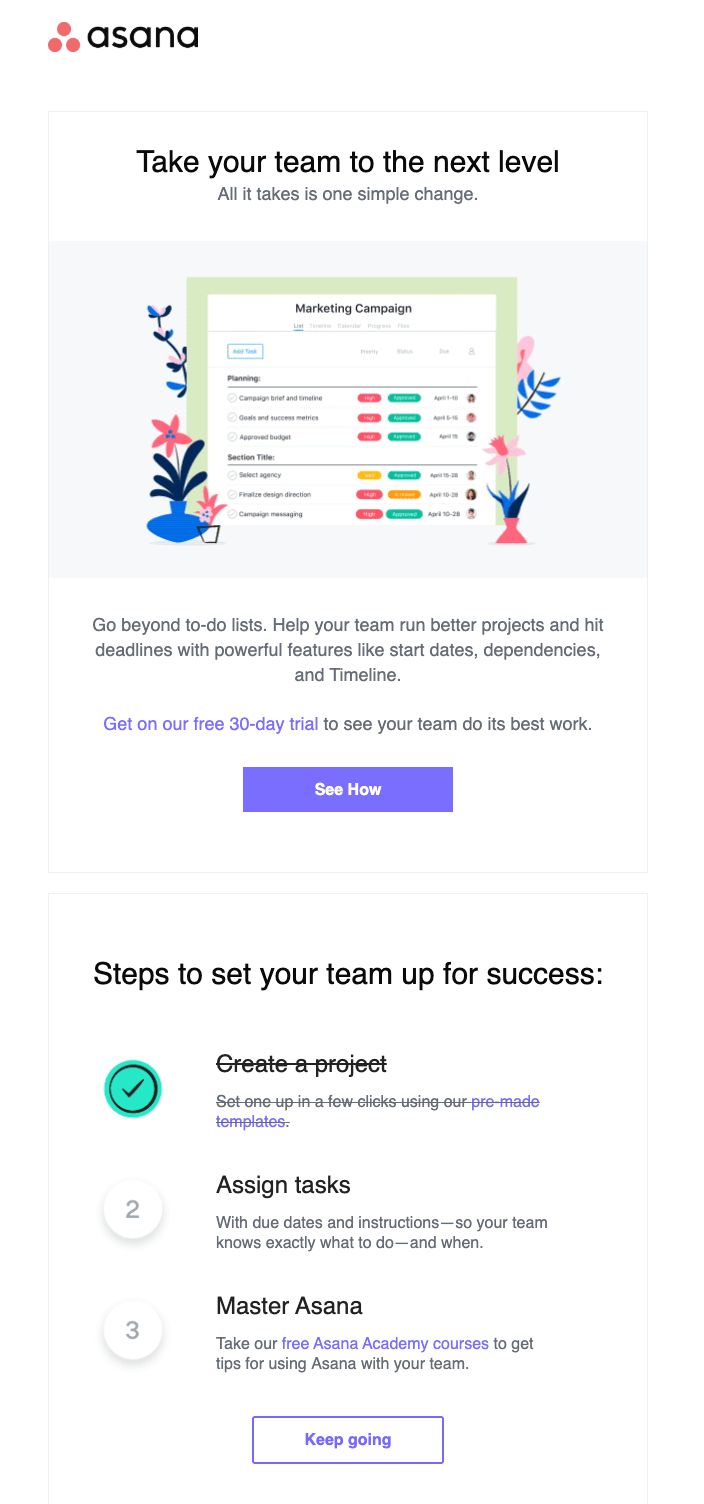
Cart Abandonment Email by Nykaa
This email by Nykaa, an online beauty, wellness, and fashion store, uses dynamic personalization to send a cart abandonment recovery email.
It highlights the price drop of an item in the user’s cart, enticing them to complete the purchase. The email also provides coupons for products the user usually buys. This is done by analyzing purchase history and browsing patterns.
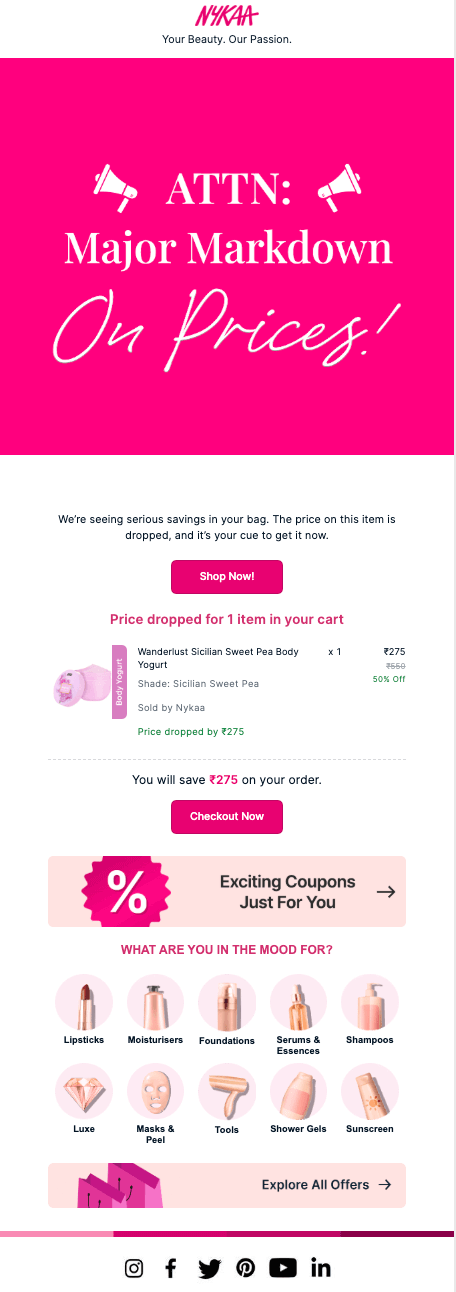
Win-Back Email by Khan Academy
This win-back email from Khan Academy, a non-profit educational organization, uses the fear of missing out (FOMO) and an account deactivation warning to re-engage inactive customers.

Common Challenges and How to Overcome Them
Here are some common challenges in running a successful data-driven email marketing campaign and ways to tackle them.
- Disconnected tools and platforms result in data silos and marketers are unable to create a unified customer journey. Integrate all relevant platforms using APIs to sync data in real time.
- An email list with inactive subscribers or invalid data will add friction to the campaign by lowering deliverability and increasing the risk of being marked as spam. Maintain email list hygiene through regular audits to remove invalid and inactive contacts.
- Customer data is sensitive and private. Violating privacy laws results in penalties and affects brand reputation. Use transparent opt-in processes and comply with GDPR, CCPA, and other regulations.
- Too much data can be overwhelming, so focus on interpreting and analyzing the data that aligns with the email marketing campaign goal.
Best Practices for Data-Driven Email Marketing Success
Follow these email marketing best practices for higher conversions.
- Start with small, focused campaigns and optimize iterations based on performance data.
- Send fewer, highly targeted, and relevant emails that resonate. Prioritize relevance over email volume.
- Use behavioral, demographic, and psychographic data for hyper-personalization. Do not just use the first name and call it a day.
- Regularly clean and update your email list to maintain high deliverability.
- Continuously test email elements like subject lines, CTAs, send times, email content, and design via A/B or multivariate testing.
Shift from Intuition to Insights
Traditional email marketing has received a data makeover. The updated version no longer relies on the market’s intuition, which, like all human things, is prone to be incorrect. Data is concrete and does not lie.
Make the shift from gut-feeling to insight and data-driven email marketing campaigns. Quantify user behavior and engagement, and align them with business goals to measure campaign success.
Learn how to build data-driven, automated journeys for every major holiday email campaigns. Start with launching your 4th of July email campaigns with CleverTap!
Subharun Mukherjee 
Heads Cross-Functional Marketing.Expert in SaaS Product Marketing, CX & GTM strategies.
Free Customer Engagement Guides
Join our newsletter for actionable tips and proven strategies to grow your business and engage your customers.















































